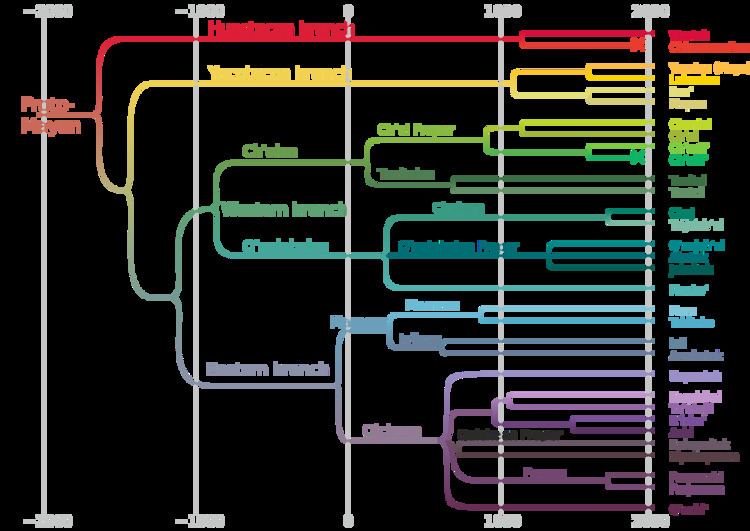 | ||
Proto-Mayan is the hypothetical common ancestor of the 30 living Mayan languages, as well as the Classic Maya language documented in the Maya inscriptions.
Contents
Phonology
The Proto-Mayan language is reconstructed (Campbell and Kaufman 1985) as having the following sounds:
Five vowels: a, e, i, o and u. Each of these occurring as short and long: aa, ee, ii, oo and uu,
Sound rules
The following set of sound changes from proto-Mayan to the modern languages are used as the basis of the classification of the Mayan languages. Each sound change may be shared by a number of languages; a grey background indicates no change.
Developments
The palatalized plosives [tʲʼ] and [tʲ] are not carried down into any of the modern families. Instead they are reflected differently in different branches allowing a reconstruction of these phonemes as palatalized plosives. In the western branch (Chujean-Q'anjob'alan and Cholan) they are reflected as [t] and [tʼ]. In Mamean they are reflected as [ts] and [tsʼ] and in Yukatek and K'ichean as [tʃʰ] and [tʃʼ].
The Proto-Mayan liquid [r] is reflected as [j] in the western languages (Chujean- Q'anjob'alan and Cholan), Huastecan and Yukatek but as [tʃʰ] in Mamean and [r] in K'ichean and Poqom.
Proto-Mayan velar nasal *[ŋ] is reflected as [x] in the eastern branches (K'ichean Mamean), as [n] in Q'anjob'alan, Cholan and Yukatekan, and only conserved as [ŋ] in Chuj and Poptí. In Huastecan *[ŋ] is reflected as [h].
The changes of Proto-Mayan glottal fricative [h] are many and it has different reflexes according to position. In some positions it has added length to the preceding vowel in languages that preserve a length distinction. In other languages it has the reflexes [w], [j], [ʔ], [x] or a zero-reflex.
Only K'ichean-Mamean and some Q'anjob'alan languages have retained Proto-Mayan uvular stops [q] and [qʼ] whereas all other branches have changed these into [k] and [kʼ] respectively.
In Mamean a chain shift took place changing *[r] into [t], *[t] into [tʃ], *[tʃ] into [tʂ] and *[ʃ] into [ʂ]. These retroflex affricates and fricatives later diffused into Q'anjob'alan.
In polysyllabic words Kaqchikel and Tz'utujil have changed a final Proto-Mayan *[w] and *[ɓ] into [j] and *[ʔ] respectively.
Huastecan is the only branch to have changed Proto-Mayan *[w] into [b]. Wastek also is the only Mayan language to have a phonemic labialized velar phoneme [kʷ], but this is known to be a postcolonial development. Comparing colonial documents in Wastek to modern Wastek it can be seen that they were originally clusters of [k] and a rounded vowel followed by a glide. For example the word for "vulture" which in modern Wastek is pronounced [kʷiːʃ] was written <cuyx> in colonial Wastek and pronounced [kuwiːʃ].
The Yucatecan languages have all shifted Proto-Mayan *[t] into [tʃ] in wordfinal position.
Several languages particularly Cholan and Yucatecan have changed short [a] into [ɨ].
All Cholan languages have changed long proto-Mayan vowels [eː] and [oː] into [i] and [u] respectively.
Vowel length distinction has been lost in Q'anjob'alan-Chujean (except for Mocho' and Akateko), Kaqchikel and Cholan. Some languages have reduced the vowel length distinction into a tense lax distinction that was later lost for most vowels, Kaqchikel however retains a centralized lax schwa-like vowel as a reflex of Proto-Mayan [a]. Two languages, Yukatek and Uspantek and one dialect of Tzotzil have introduced a tone distinction in vowels between high and low tones as reflexes of former vowel length and [h] and [ʔ].
